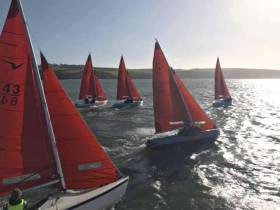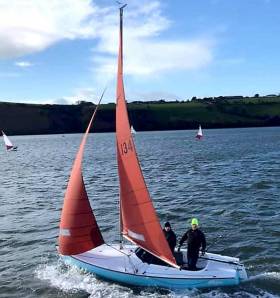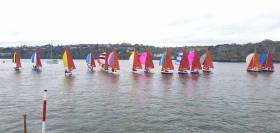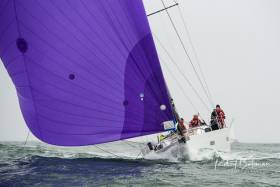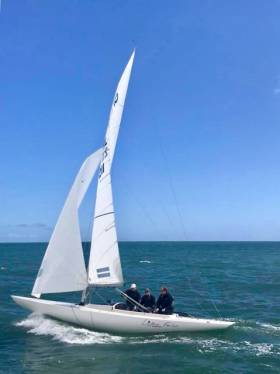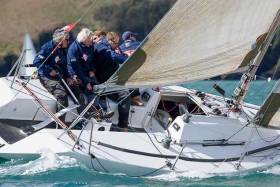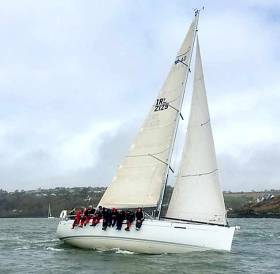Displaying items by tag: Kinsale Yacht Club
Strong Winds Cut Short Kinsale Frostbite Yacht Racing
A strong SW breeze greeted our competitors on the third morning of the Custom Rigging Frostbite series in Kinsale writes Dave O'Sullivan.
Race Officer John Stallard assisted by Michele Kennelly (welcome back) and Siobhan Keane Hopcraft aboard Destiny (Bruce & June Matthews) decided that the wind was far too strong for the Toppers who were promptly sent home. The tenacious Squibs started on time at 1100 HRS followed five minutes later by the very competitive Laser fleet.
"After one race both fleets were heading for home as the wind speed had increased to 25 knots"
After one race both fleets were heading for home as the wind speed had increased to 25 knots. Everybody was ashore before 1300 HRS.
Squibs
The Squib fleet was led by Badger (J Condell & J Cochrane) with Allegro (C Dunne & R Gill) second and Sensation (D & B Cudmore) third. Sensation just pipped Outlaw (I Travers & K O’Riordan) at the finish line with Outlaw having to tack off at the last second as Sensation came through on Starboard.
Overall positions after seven races -
Allegro 1st, Badger 2nd and Outlaw 3rd.
Lasers
The tough conditions suited the more experienced sailors and the five boat Fleet was led by Dorothy Matthews with Tiarnan Brown second and Rory Carroll third.
Overall positions after six races -
Dorothy Matthews 1st, Robert McGarvey 2nd and Rory Carroll 3rd.
It will all start again next Sunday 17th at 1100 HRS.
Kinsale Yacht Club Stage Blustery Second Race of Frostbites Series
Another amazing sunny day greeted the sailors competing in the Custom Rigging Frostbites in Kinsale Yacht Club on Sunday 10th February writes Dave O'Sullivan. Race Officer John Stallard assisted by Sue Horgan aboard Destiny (Bruce & June Matthews) fixed a weather mark in blustery SW conditions and got the fleet away promptly at 1100.
The Toppers and Lasers sailed two races before a rising wind created boisterous conditions later in the day. The hardy Squib fleet got in a third race with a very exciting spinnaker run on the last downwind leg giving plenty of spills and thrills.
Three fleets raced (Squibs, Topper and Lasers) with 24 boats in all.
Squibs
The ten boat Squib fleet was led by Allegro (Colm Dunne & Rob Gill) who got two firsts and a third with Outlaw (Ian Travers & Keith O’Riordan) close behind with a fifth and two seconds and Badger (J Condell & J Cochrane) lying third overall with a second, a first and a fourth. Sensation (D & B Cudmore) scored two thirds and a fourth on their first day out, having missed last week, putting them very much in contention with four more race days to go.
Lasers
The five boat Laser Fleet was led by Dorothy Matthews with two firsts followed by Robert McGarvey with a second and a fourth. Rory Carroll is lying third on the day with a fifth and a third. Daniel Ackerlind who has just joined the fleet put in a great performance on his first day out with a third and a second.
Toppers
The eight Topper fleet was led by Rachel Ackerlind with two firsts putting her in fourth place overall. Frances Corkery with a second and a third is still first overall closely followed by Hanna Ackerlind in second place overall and Francesca Lewis in third place overall.
It will all start again next Sunday 17th at 1100 HRS.
Kinsale Yacht Club Dinghies & One Designs Prepare for Frostbite Series
12 races over six weekends for Squib, Laser, Topper, and mixed Dinghy fleets gets the 2019 sailing season off to a flying start in Kinsale next month.
Racing will be on laid courses within the harbour off Charles Fort with a First Gun of 10:55hrs each day starting on February 3rd.
An entry Fee of €40 single handed and €60 for all others applies for the Custom Rigging sponsored Frostbite Series.
See KYC web site www.kyc.ie for further details including entry forms and SI’s
Doyle's Xp50 'Freya' in Fine Form for Yacht Race From Kinsale to Monkstown
Kinsale Yacht Club's 'Mary P' Race and Cruise organised by Neil Prendeville from Kinsale to Monkstown on Saturday morning took just two hours for Conor Doyle's new Freya XP50 to complete.
The six KYC boats in the 'All In' Echo, IRC and White Sails fleet then joined the Cork Harbour Cobh to Blackrock Race later that day. See our Cobh to Blackrock Race photo gallery by Bob Bateman here.
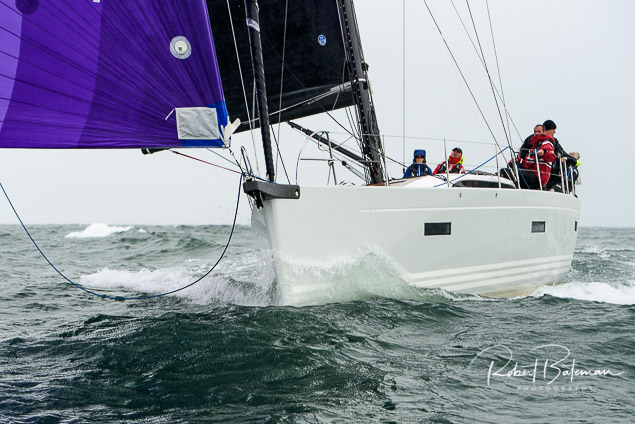 (Above and below) Conor Doyle's Freya in the race from Kinsale to Monkstown Photo: Bob Bateman
(Above and below) Conor Doyle's Freya in the race from Kinsale to Monkstown Photo: Bob Bateman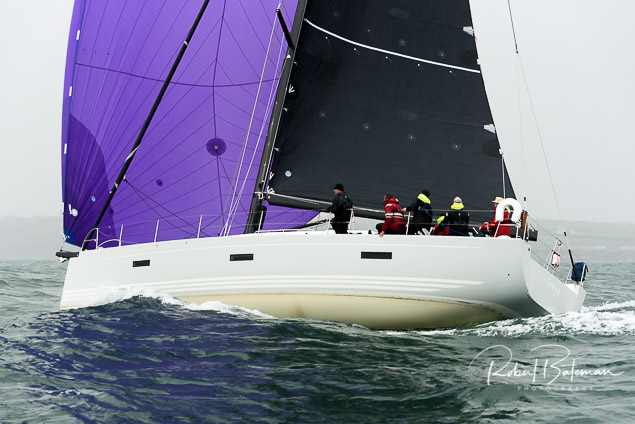
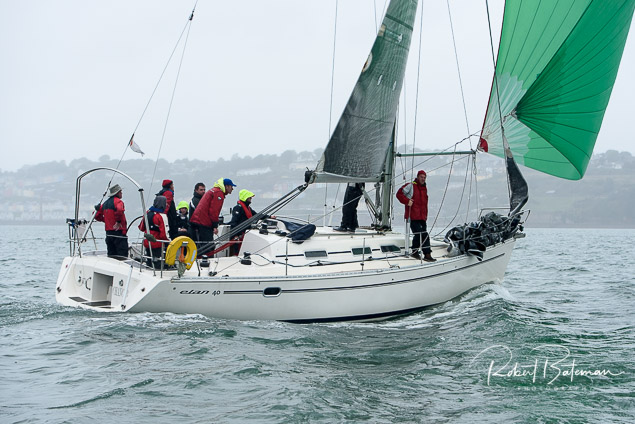 The Elan 40 Chancer (Carroll Bros)
The Elan 40 Chancer (Carroll Bros) The Elan 333 Artful Dodger skippered by Finbarr O'Regan Photo: Bob Bateman
The Elan 333 Artful Dodger skippered by Finbarr O'Regan Photo: Bob Bateman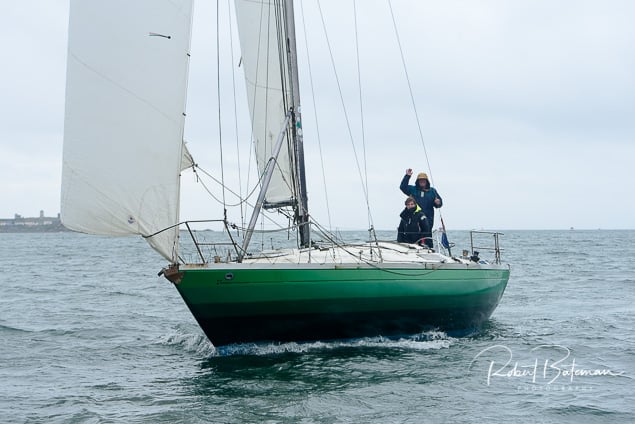 KYC's Chameleon (Padraic O'Donovan) Photo: Bob Bateman
KYC's Chameleon (Padraic O'Donovan) Photo: Bob Bateman
Conor Doyle's Maiden Success off Kinsale with New XP 50 Yacht Freya
Conor Doyle's new XP 50 Freya that expected to make her racing debut at the ill-fated ICRA Nationals in Galway Bay last month, won her maiden race instead at her home port of Kinsale last week.
Competing in Kinsale Yacht Club's Autumn midweek series last Wednesday, Doyle's Danish built X-Yacht was first home on IRC and ECHO.
Kinsale Yacht Club Triangle Race Stopover Success
The Triangle Race double-handed challenge open to cruiser and cruiser-racer monohull yachts of 25ft LOA or over, organised by the Royal Torbay Yacht Club had a successful stop over at Kinsale Yacht Club over the last few days. The fleet left Kinsale on the next leg this morning and three Cork boats are competing.
The event runs, on even-numbered years, from Torquay to Kinsale Southern Ireland to Tréguier Brittany and back to Torquay, a distance of at least 620 miles and lasting 12 days.
At least two days are spent in each port with receptions, parties and shore-based ‘competitions’ as well as impromptu parties ashore and afloat.
 Triangle Race competitors during the Kinsale stopover Photo: Bob Bateman
Triangle Race competitors during the Kinsale stopover Photo: Bob Bateman
The three Cork entrants this year are pictured below:
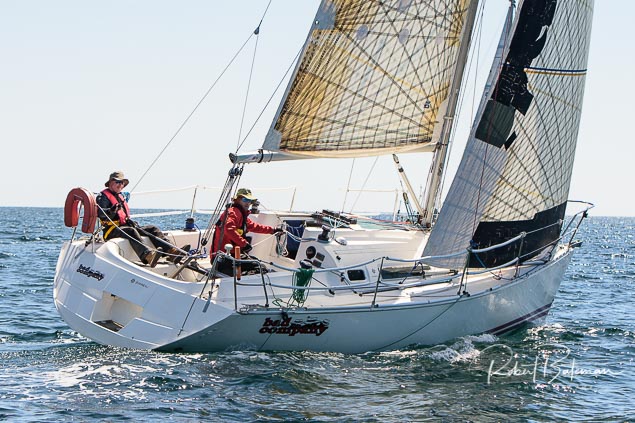 Bad Company skippered by Mark Ivers from Royal Cork Photo: Bob Bateman
Bad Company skippered by Mark Ivers from Royal Cork Photo: Bob Bateman
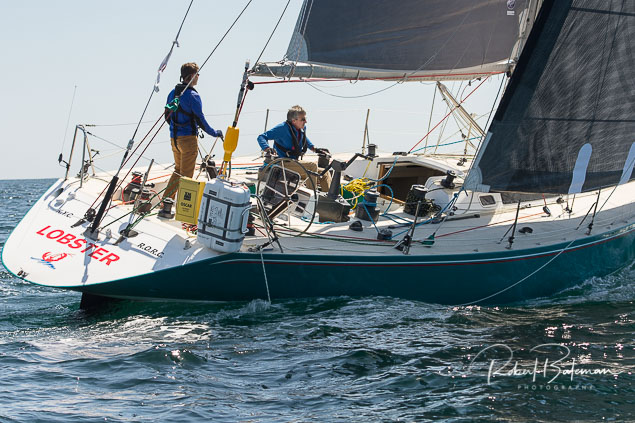 Gary Horgan's Lobster from Kinsale Photo: Bob Bateman
Gary Horgan's Lobster from Kinsale Photo: Bob Bateman
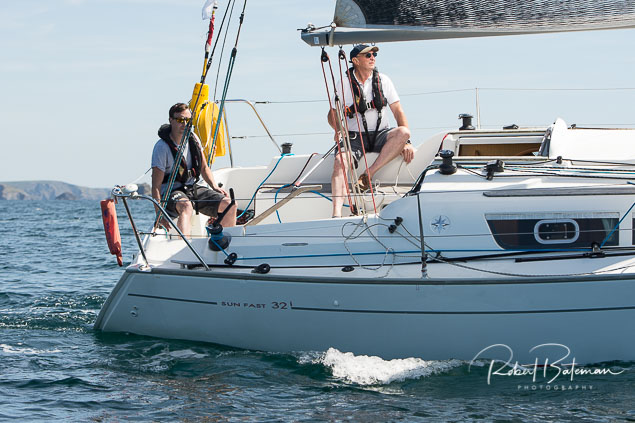 Siboney – John and Kevin Stallard from Kinsale Photo: Bob Bateman
Siboney – John and Kevin Stallard from Kinsale Photo: Bob Bateman
Cian McCarthy and the crew of Eos was the winner of Kinsale Yacht Club's 'all–in' race for the Bertoletti Trophy sailed on Friday.
Every year in June, KYC boats including Cruisers, Dragons, 1720’s, Squibs and Sonars race for the trophy that commemorates the late KYC steward Mario Bertoletti who served at the club from the 1970’s for over 30 years.
'Mario’s competence, style and unfailing good humour were a huge asset to KYC that played a huge part in the club's success', Commodore David O'Sullivan told Afloat.ie
Blue skies, flat seas and a gentle breeze saw a fleet of 5 Squibs, 4 Dragons and 13 Cruisers take part in the Bertoletti Trophy race on Friday last in Kinsale. This event is held in memory of Mario Bertoletti who was for many years the Club Steward. The trophy was given to the club by his wife Patricia and their
The course was out to the Bulman buoy then back into the outer harbour. Given the light airs the Race Officer, Michele Kennelly, followed the fleet in case the course needed to be shortened. Cian McCarthy’s Eos rounded the buoy in pole position, with Siboney, Lobster and Justus jockeying for position behind him. Unfortunately, Siboney was white sailing which meant that once the spinnakers went up John Stallard and crew lost out. Having seen some of the fleet around the buoy the next decision for the Michele was when, not if,
to shorten as the breeze was getting lighter all the time.
The fleet came back into the harbour under spinnaker which made for an impressive sight. Eos was still in front and finished the race an impressive 10 mins ahead of John Godkin’s Godot. This secured Eos 1 st place. Cian O’Regan on Artful Dodger came home just 2’ 8” behind Dan Buckley on Justus which secured 2nd place for him and Justus was 3rd. 5 boats retired from the race as the breeze died almost completely and it was the tide that brought the last of the finishers across the line. The first Dragon home was Serafina, Maeve Cotter/Daniel Murphy/Sean Murphy and the first Squib was Fuggles with Sam & Sara Hunt.
Back in the club Patricia Bertoletti and family presented the Trophy to Cian McCarthy and Eos.
Sunshine and sparkling waters provided the backdrop to an excellent sailing weekend at Kinsale Yacht Club.
Sponsored by Barry Ryan, the Kinsale Keelboat Regatta was sailed over two days and provided championship windward leeward competition with a particularly stiff wind late on Sunday giving a spectacular finish to this long established event.
With a first gun each day at 1155 HRS, six races were sailed off Kinsale Harbour between Bulman Rock and Black Head. The Squib fleet was dominated by Allegro (134) finishing up with six points after a discard scoring five bullets in all. Outlaw (785) and Sensation (523) had a good tussle for second place with Outlaw just clinching it in the end.
 Squib winner 134 Allegro
Squib winner 134 Allegro
The Dragon fleet were more equally matched on day one but Little Fella (211) got into its stride on day two and scored three firsts romping home with six points overall followed by Serafina (180) and Grey Hare (188) on ten and sixteen points respectively. In addition to local Kinsale Dragons, excellent competition was provided by two visiting Glandore yachts, the elegant green Aphrodite (110) and shiny white Laurus (131).
KYC Commodore Dave O’Sullivan and team officiated.
Results -
Squibs
Allegro (134) Dunne & Ward
Outlaw (785) Travers & O’Riordan
Sensation (523) Cudmore & Cudmore
Dragons
Little Fella (211) Good, Kingston & Furney.
Seraphear (180) Cotter, Murphy & Goggin
Grey Hare (188) Kingston, Kingston & Lewis.
Sponsor Wins Own Race at Kinsale Yacht Club's April League
- Event Sponsor James Matthews was back in form and Diamond regained the IRC trophy secured last year.
- Conor Phelan’s Jump Juice first place on the water secured the overall winners spot for IRC Class 1 over Denis Murphy’s Nieulargo
- Peter Collins maintained the impressive form of his Olsen 30 to take line honours
The Child of Prague was put out on Friday night and for the second week in a row, competitors in the Matthews Helly Hansen sponsored April League hosted by Kinsale Yacht Club enjoyed a spell of sunshine that was decent enough to warrant dusting off the factor 50 sun cream writes Michael Walsh.
Once enough breeze had filled, PRO Denis Kieran called for the AP to be removed to allow the day’s proceedings and some more champagne sailing to get underway across Kinsale’s Outer Harbour.
The light north easterly breeze was due to shift southwards which ultimately it did, meaning the Round the Cans course from Bullens Bay over to the Sovereigns Islands allowed for plenty of sunny photographs of boats finishing under full spinnakers at the Bulman buoy.
Conor Phelan’s Jump Juice first place on the water secured the overall winners spot for IRC Class 1 over Denis Murphy’s Nieulargo , with Paul Tingle’s Alpaca completing the rout for the Crosshaven fleet.
Kieran Collins maintained the impressive form of his Olsen 30 to take line honours from KYCs Finny O Regan in IRC Class 2 and secured the silverware for Crosshaven in this fleet for both IRC and Echo .
Event Sponsor James Matthews was back in form and Diamond regained the IRC trophy secured last year. Headcase finished in second place and Flyover in third.
A special mention of thanks to Rear Commodore Susan Horgan for organizing the barrebue and for her dedicated assistance on the Race Management Team for the whole series. Also a huge thanks to Race Officer Denis Kieran and to Tony & Ciara O’Brien for providing such a warm welcome and wonderful refreshments each week aboard committee boat White Tiger.
Overall results for the Matthews Helly Hansen April League:
Class 1 IRC : Conor Phelan’s Jump Juice
Class 1 Echo: Denis Murphy Nieulargo
Class 2 IRC: Kieran Collins’s Oracle IV
Class 2 Echo: Kieran Collins’s Oracle IV
Class 3 IRC: James Matthews’s Diamond
Class 3 Echo: O ‘Halloran & Helstern Headcase
Whitesail: Sammy Cohen’s Gunsmoke II
See photos from KYC league here
A strong south east breeze provided Kinsale Yacht Club's Matthews Helly Hansen sponsored Spring Series with two excellent races.
Race one got away promptly at noon with the round the cans course finishing at Charles Fort. Race two got away at 1330 sailing a longer course, taking in Black Head. Only a few brave yachts flew spinnakers early in the day but the breeze decreased slowly from 24 knots and the horizon was awash with spinnakers when the fleet came into Kinsale on the last leg of race three from centre point.
Denis Murphy’s Grand Soleil 40 Nieulargo dominated Class One. Shane Stratham’s evergreen GK 34 Slack Alice put in a top performance in Class Two. Matt Hellstern’s new arrival J/24 Headcase proved to be the fleet leader in Class Three. In White Sail KYC boats Paragon and Priviteer won a race each.
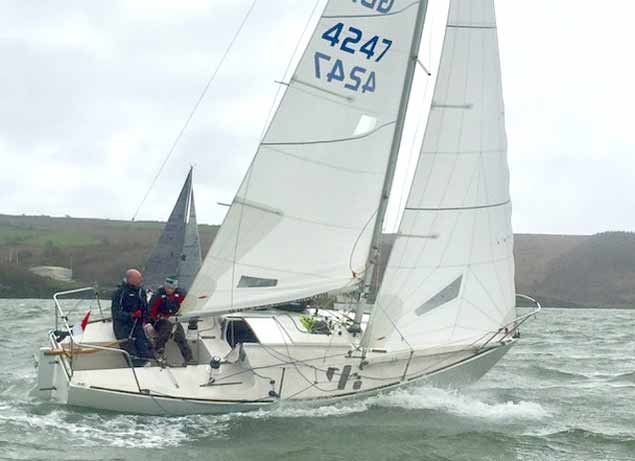 Matt Hellstern’s J/24 was a fleet leader in Class three
Matt Hellstern’s J/24 was a fleet leader in Class three
Race four FG is at the earlier time of 10.55HRS on Sunday 22nd with two races planned.
Results below
Race 2 and 3 IRC
Class One
Nieulargo
Jump Juice
Alpaca
Race 2 ECHO
Nieulargo
EOS
Alpaca
Race 3 ECHO
Nieulargo
Jump Juice
Justus
Class Two
Race 2 ECHO
Slack Alice
Artful Dodger
Oracle
Race 2 IRC
Oracle
Artful Dodger
Slack Alice
Race 3 ECHO
Slack Alice
Artful Dodger
REAVRA TOO
Race 3 IRC
Slack Alice
Artful Dodger
Oracle
Class Three
Race 2 ECHO and IRC
Headcase
Diamond
Fulmar Fever
Race 3 IRC
Headcase
Fulmar Fever
Diamond
Race 3 ECHO
Fulmar Fever
Headcase
Flyover
White Sail
Race 2
Paragon
Privateer
Gunsmoke II
Race 3
Privateer
Sweet Dreams
Paragon


























